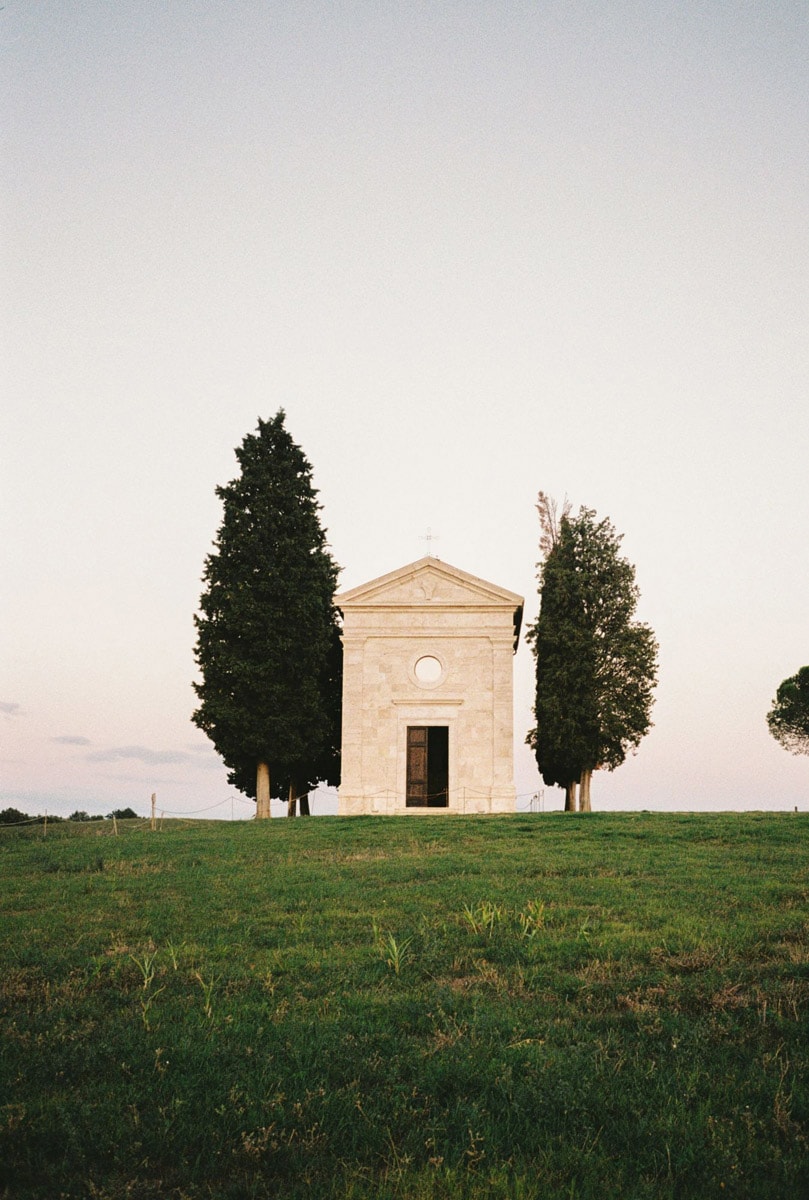Alexia and I visited Val d’Orcia for S&T’s wedding at La Foce in September 2023 and we relished the chance to explore the region’s renowned landmarks.
This brief travel guide is tailored for a relaxed two-day escape in Val d’Orcia. Join us as we guide you through a cultural exploration of the famed rolling hills and unveil the locations where some renowned films were shot!

Pienza

The charming village of Pienza, is approximately 20 kilometers east of Montalcino and a few kilometers west of Montepulciano.
For those eager to follow in the footsteps of gladiators, two easily accessible places await exploration. The Gladiator’s renowned house is situated in San Quirico d’Orcia. Look for the gate of the Manzuoli farm on the left – that’s the entrance to the famous house! The landscape of the final scene in the Gladiator movie is in Pienza, reached via a dirt road descending from Pieve di Corsignano.
Among many the cinematic gems, “The English Patient” was also filmed captured its scenes between Montepulciano and Pienza. Piazza Pio II in Pienza and the streets of Cosona, a fortified complex dating back to the 1400s, provided the evocative settings for much of the movie’s shooting.


Chapel of the Madonna di Vitaleta
Situated near San Quirico d’Orcia, between the towns of San Quirico d’Orcia and Pienza, the Chapel of the Madonna di Vitaleta stands as a captivating monument. This tall and luminous chapel is surrounded by cypress trees, contributing to the enchanting atmosphere of the entire area, which has been designated a UNESCO World Heritage Site.
Framed by two rows of majestic cypress trees, the small chapel occupies the legendary site where, according to folklore, the Virgin Mary appeared to a shepherdess. In 1533, a statue of the Virgin Mary, skillfully crafted by Andrea della Robbia, found its place in the chapel, and it is now preserved in the Church of Madonna di Vitaleta in San Quirico.


Currently, San Quirico d’Orcia commemorates the “Festa della Madonna di Vitaleta” annually between August and September. The parish hosts religious ceremonies, and two days are dedicated to lively performances in the square.
Today, the chapel remains one of Tuscany’s most photographed locations, with its light colors standing in stark contrast against the rolling hills of the Val d’Orcia, creating a visually captivating spectacle. It provides an ideal setting for a romantic day trip, or perhaps even a picnic in the fields. Next to the chapel, a small restaurant offers the perfect spot to enjoy a glass of wine while taking in the breathtaking countryside.
To reach the chapel, you will need to park a short distance down the road and embark on a brief hike.

Montepulciano
Renowned for its medieval charm and stunning Renaissance architecture, this hilltop town is a haven for those seeking a genuine Italian experience.

The cobbled streets of Montepulciano wind their way through ancient buildings, revealing hidden corners and panoramic views.
The town is celebrated for its Vino Nobile, a robust red wine produced from the nearby vineyards that carpet the landscape. Wine enthusiasts can indulge in tastings at historic cellars, gaining insight into its centuries-old winemaking traditions.
Montepulciano’s Piazza Grande, with its imposing Palazzo Comunale and the elegant Duomo, serves as the beating heart of the town, offering a perfect glimpse into local vitality.
Whether wandering through the sun-drenched streets, sipping wine in charming enotecas, or simply soaking in the breathtaking vistas, Montepulciano is a prime example of Tuscan beauty, culture, and the art of living well.













While Volterra, Italy is a real town in Tuscany, Italy, the Volterra scenes for the movie Twilight: New Moon were filmed in Montepulciano, Italy. Author Stephenie Meyer had decided that the exact location (whether real or fictional), would be about 2 hours from Florence and would have a piazza and clock tower and Montepulciano perfectly fitted her descriptions.
Civita di Bagnoregio
Civita di Bagnoregio is situated on the outskirts of the municipality of Bagnoregio approximately 120 kilometres north of Rome.
The town relies on a rock foundation vulnerable to significant erosion from wind and water, leading to a gradual but seemingly inevitable decline.
Over time, the residents of Civita departed, seeking more stable ground, leaving the town with only 11 inhabitants!
This distinctive narrative is what distinguishes Civita di Bagnoregio, earning it the moniker “Italy’s dying town.”
Despite this disconcerting backdrop, a visit to Civita di Bagnoregio reveals a delightful destination that defies its “dying” designation. Far from a ghost town, it boasts charming restaurants, lively wine bars, and breathtaking views, exuding both vitality and historical allure.
Access to Civita is exclusively through a footbridge from the neighboring town.



La Foce

While you’re in the vicinity, make sure to explore La Foce, one of Tuscany’s most prestigious villas. I photographed S&T’s two-day wedding here. Although it may occasionally be closed for private events, the garden is typically accessible for guided tours.
Fun fact: La Foce served as a backdrop for some scenes of the series “The Succession”. I’ve compiled a comprehensive post highlighting the beauty and history of this remarkable location, and you can check it through the link below:




